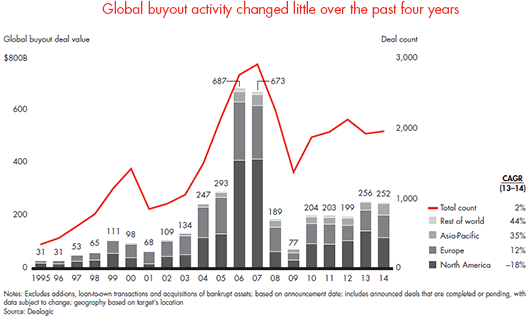Forbes.com
This article originally appeared on Forbes.com.
Private equity (PE) buyout activity has been remarkably flat since the latest expansion cycle kicked into gear back in 2010, a trend that shows little sign of changing. Unlike in past cycles, when deal making steadily gained momentum as confidence in the upswing solidified, recent buyout activity has barely budged since snapping back from 2009’s recessionary levels (see figure). In fact, as we discuss in Bain & Company’s Global Private Equity Report, buyout firms announced 1,955 transactions in 2014—only 85 more than in 2010—with a total deal value of $252 billion.

The apparent calm on the new-investment front masks intense—and growing—deal-making pressures just beneath the surface. The forces at work cut two ways. First, PE funds’ keen hunger to buy in an environment of intense competition, on the one hand, did battle with general partners’ (GPs) self-imposed restraint not to overpay. Second, the continued rise of the public equity markets has lifted the floor on valuations that prospective PE buyers face, increasing acquisition multiples to levels that price many deals out of reach.
Vast sums of undeployed capital in the hands of a record number of PE firms has been the biggest factor propelling deal making forward in 2014. Nearly 6,000 active PE firms (more than 1,000 of them buyout firms), wielding $1.2 trillion in dry powder ($452 billion of it earmarked for buyouts), were in the hunt for acquisitions by the end of 2014.
Lenders desperate for yield flocked to PE, holding down the cost of debt for buyouts and offering favorable terms to issuers as the supply of credit far outpaced demand. Average multiples of debt used in leveraged buyouts in 2014 continued to climb in the US and Europe, inching back up to levels last seen during the prerecession years of 2006 and 2007.
Instead of greasing the skids of global deal making, however, these vast sums of dry powder, supplemented by abundant cheap debt, complicated matters in a capital-saturated market where attractive assets were in limited supply. Continued buoyant public equity markets set a firm floor under asset valuations. According to data analyzed by S&P Capital IQ through the middle of 2014, purchase-price multiples for leveraged buyouts in the US averaged 9.6 times earnings before interest, taxes, depreciation and amortization (EBITDA) and 10 times EBITDA in Europe—highs the market had not seen since the peak of the last cycle.
High asset prices were not the only constraint weighing on PE acquirers in 2014. Would-be buyers ran into stiff competition from familiar deal-making rivals. Flush with record-high levels of cash, corporations remained active acquirers, as they have been since the start of the economic recovery. The total value of global corporate mergers and acquisition activity hit $2.8 trillion, more than 11 times greater than all buyout activity for the year and its peak level during the current expansion. And businesses seeking capital had other options than selling to private equity. They could tap the robust equity or debt markets, issuing public shares or bonds.
Finally, self-imposed and externally applied restraints also reined in PE deal making. Coming out of the global financial crisis, PE funds have avoided joining forces with one another in the big club deals that were so popular in 2006 and 2007. Squeezing PE deal size from the debt side, regulators are trying to limit the amount of leverage on deals. In the US, for example, regulators have issued guidance to banks not to finance takeovers where debt exceeds six times EBITDA.
Taken together, the caps on the amounts of equity and debt that can be marshaled to conduct a transaction keep a fairly tight lid on deal size. Limitations like those take potential deals off the table—not just big public-to-private conversions but also large sponsor-to-sponsor deals and carve-outs. The buyout market today is composed almost exclusively of deals valued at less than $5 billion.
The fierce competition for deals has led PE firms around the world to roam beyond their normal hunting grounds in search of new investments. Big buyout funds, for example, are pushing into the middle market. Worldwide in 2014, one out of every five buyouts valued at between $250 million and $500 million involved at least one of the top 15 largest GPs. In comparison, only one out of every eight middle-market deals attracted the biggest players at the height of the previous PE cycle.
Hunger for deals has led PE firms to get creative. Some buyout funds appear to be increasingly open to purchasing minority stakes, even when that means sacrificing the control GPs usually insist on having to build value in their portfolio holdings. PE firms are even creating their own businesses in order to put capital to work. PE investors are also showing a renewed interest in the “buy and build” strategy of making add-on investments to complement a company they already own.
With heightened competition for assets raising multiples paid on new deals to record levels, PE firms will be challenged more than ever to generate outsized returns. GPs will need to earn their success by controlling what they can. This includes becoming more creative in sourcing attractive transactions that offer unpriced value. GPs will also need to take on risks that they are comfortable underwriting in their search for great performance.
Written by Hugh MacArthur, Graham Elton, Bill Halloran and Suvir Varma, leaders of Bain & Company’s Private Equity Group.